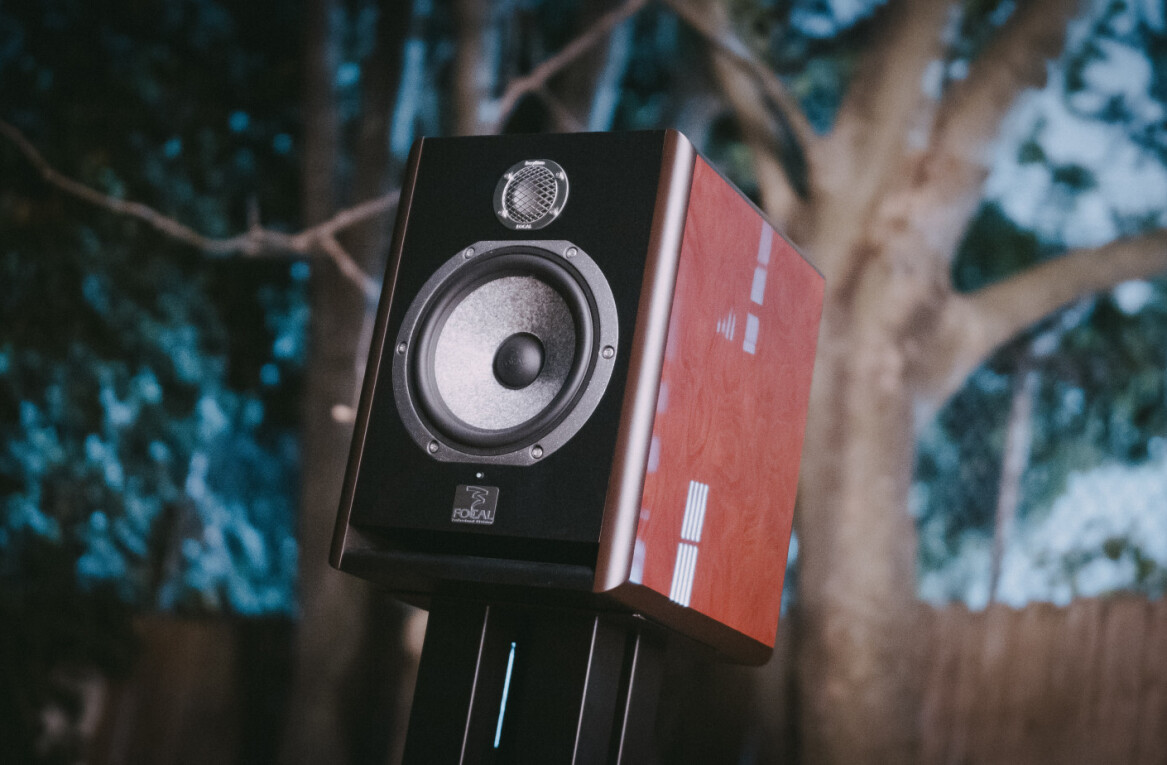
Marketing is all about hyperbole and superlatives, but marketing in the audio world is distinctly egregious. I’m particularly irked when speakers claim to let you hear music “as the artist intended” without any substance to back that up.
Genelec, a Finnish audio company, makes similar claims on its website, but it gets a pass from me. Not only does the company provide extensive measurements for each of its speakers online — each of which demonstrates a neutral response — but its speakers are prominent in the recording industry. Chances are you’ve probably heard at least some music made with Genelec speakers.
The subject of today’s review is the Genelec 8341A, part of the company’s state-of-the-art ‘The Ones‘ series. The speakers are so named because they aim to provide a truly ‘point-source’ sound, such that all frequencies emanate from the same point in space. These speakers use a unique coaxial driver — the tweeter is embedded in the mid-woofer — flanked by two unique low-end woofers in order to provide an even sound front that very few speakers can claim. This particular model is about the size of a 6.5-inch bookshelf speaker, the second smallest out of four speakers in the series.
Long story short: the Genelec 8341A are some of the best speakers I’ve had the pleasure of listening to. They’re great at just about everything and do just about nothing wrong. While no speaker will ever be the best for every single track, the 8341A has both the subjective and objective performance to justify its eye-watering, roughly $6,000 price tag (not out of the norm for its category). It’s as close to textbook ‘perfect’ as any speaker I’ve measured. The speakers may be marketed at the pro industry, but any audiophile with a fat enough wallet should have these on their radar.

It starts with the speaker’s design. The 8341A has a unique bulbous enclosure that isn’t going to be everyone’s cup of tea, but I love the futuristic look (it’s available in both black and white options). The rounded shape actually helps smooth out the acoustics, and the speaker comes with rubber feet that allow you to change the speaker’s vertical angle by a few degrees so you can aim the speakers precisely. Unlike most speakers, the 8314A also sounds nearly identical when oriented horizontally thanks to its coaxial design. Pick whatever works best for your setup.
Genelec has built a reputation for making resilient speakers — they’re intended for working professionals, after all. To that end, the 8341As are made not out of plastic or wood, but out of cast aluminum. You’ll feel it when you try to lift them up. Barring someone poking the exposed mid-woofer with a stick these speakers feel like they’ll last forever. The speakers come with a 5-year warranty upon registration (two years otherwise), and even if something goes amiss after the warranty expires, Genelec is known for stocking replacement parts for models made in the early 80s.
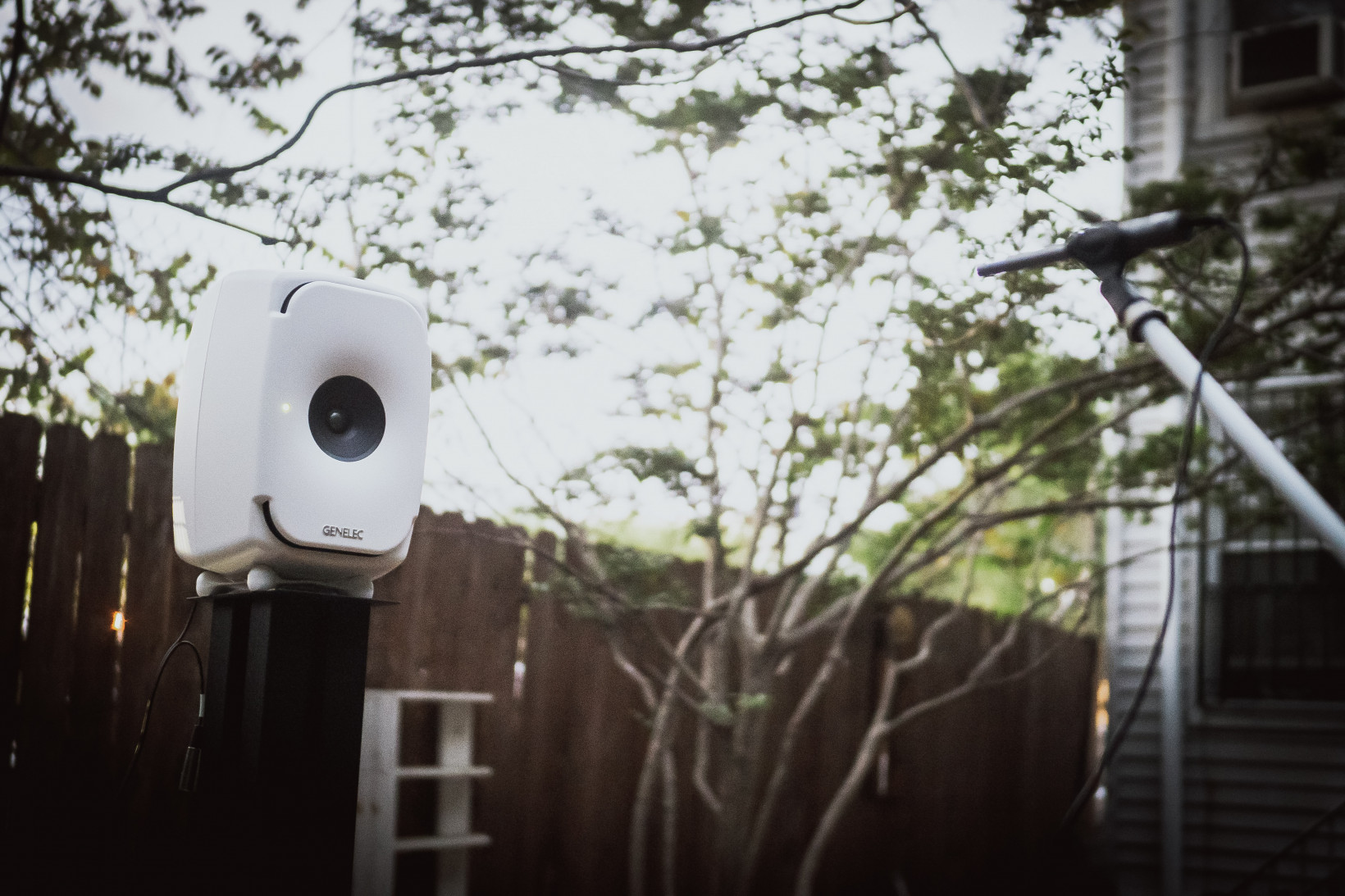
Those of you who’ve been reading my speaker reviews (hi!) know that I’m all about speaker measurements. I wrote 4,000 words on why speakers that have good measurements sound good — a notion backed up by decades of research that audio enthusiasts are increasingly factoring into their purchasing decisions.
My measurements of the 8341A show a speaker with nearly impeccable performance. Although I usually try to listen to speakers before I measured them, I’d already seen data on these speakers and knew what to expect: technical excellence. So this time around, I’m combining my listening impressions with my interpretation of the measured data.
The graph below is called a spinorama, so-called because one has to spin a speaker around to capture the sound at 70 different angles. Although this standard was developed primarily for living-room speakers, it can be useful for studio monitors as well. In any case, I spent most of my time listening to the 8341As in my living room because the distinction between hi-fi speakers and studio monitors is mostly irrelevant.
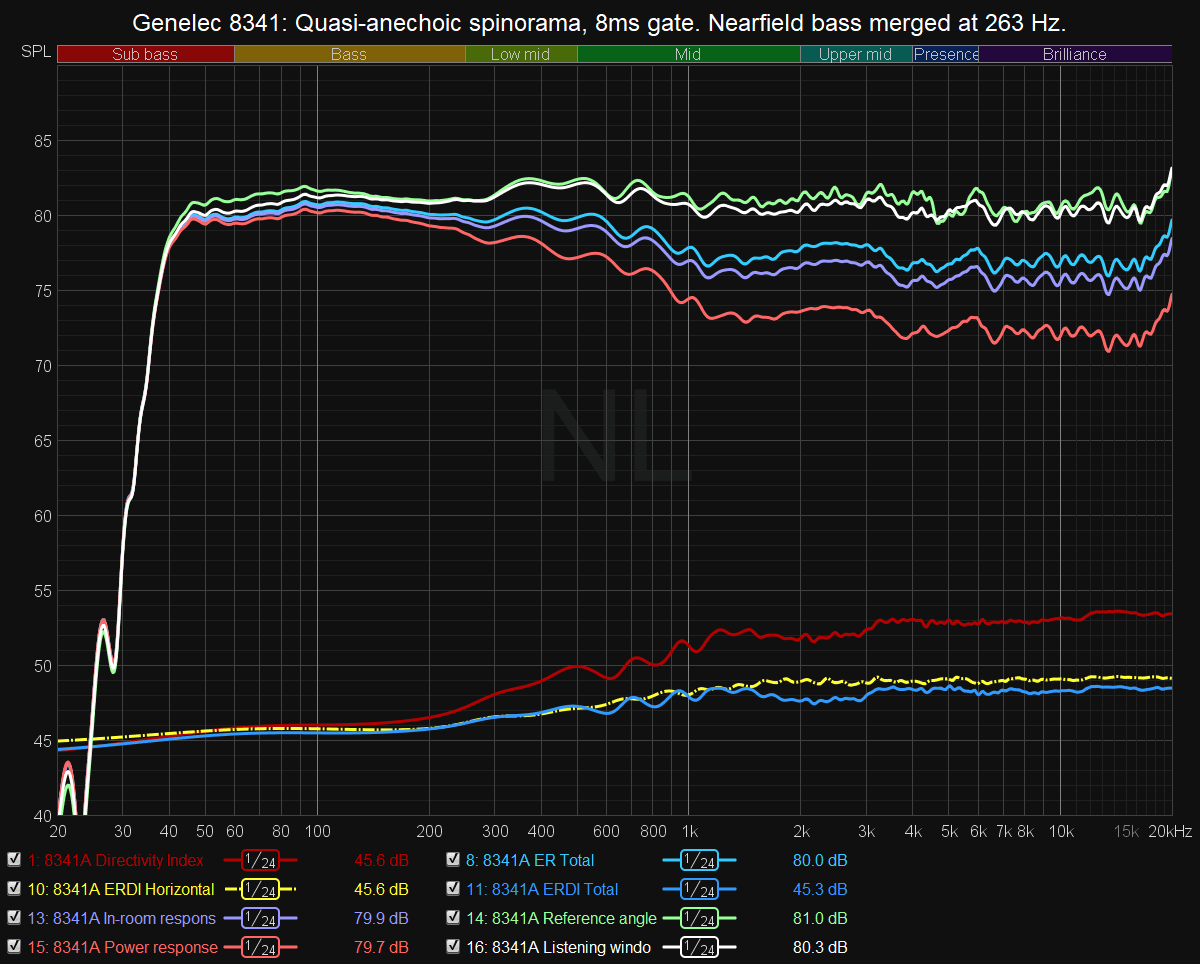
I explain what these lines mean and how they are calculated in the spinorama section of my measurements guide, but we can focus on a few key things here.
There are two key things that affect the sound you hear from a speaker. There is the direct sound that travels in a line of sight from the speaker to your head. Then there is the sound the speaker radiates in all directions, which gets reflected off your walls and eventually reaches your ears. You need good performance in both respects in order to have truly exceptional sound.
See the white and green lines above? Those represent the direct sound. The green line is the ‘on-axis’ response and the white is the ‘listening window.’ I like to focus on the listening window, as it accounts for the fact we don’t sit perfectly still or centered when listening to a speaker, and eliminates inaudible flaws that only show up perfectly on-axis.
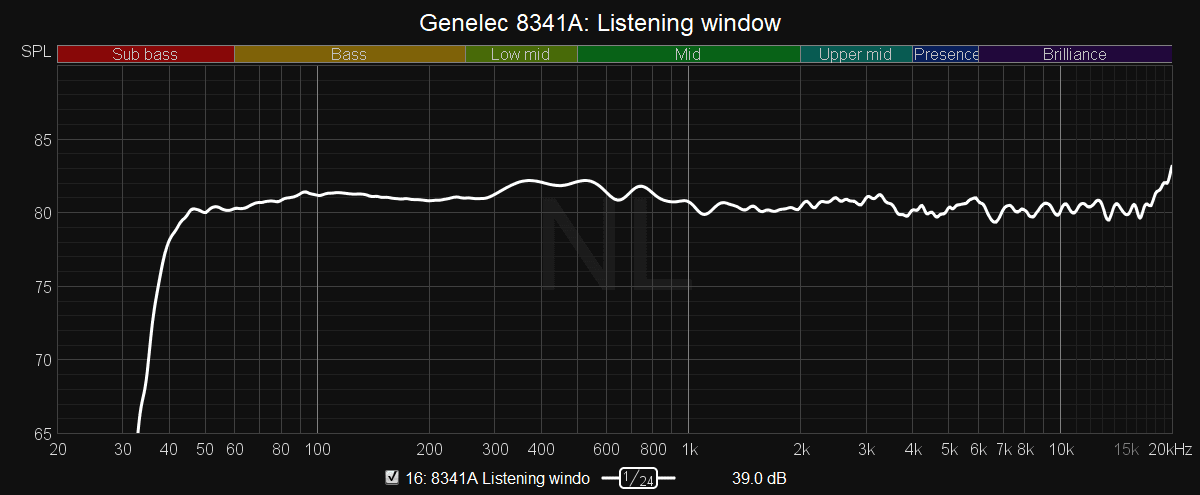
We want these two curves to look like a flat line — especially between roughly 200Hz and 10khz — for a neutral tonality. The 8341A’s listening window is as flat as any speaker I’ve measured, pushing the limits of what my measurement setup can measure.
It’s also worth mentioning that my results line-up closely with Genelec’s own:
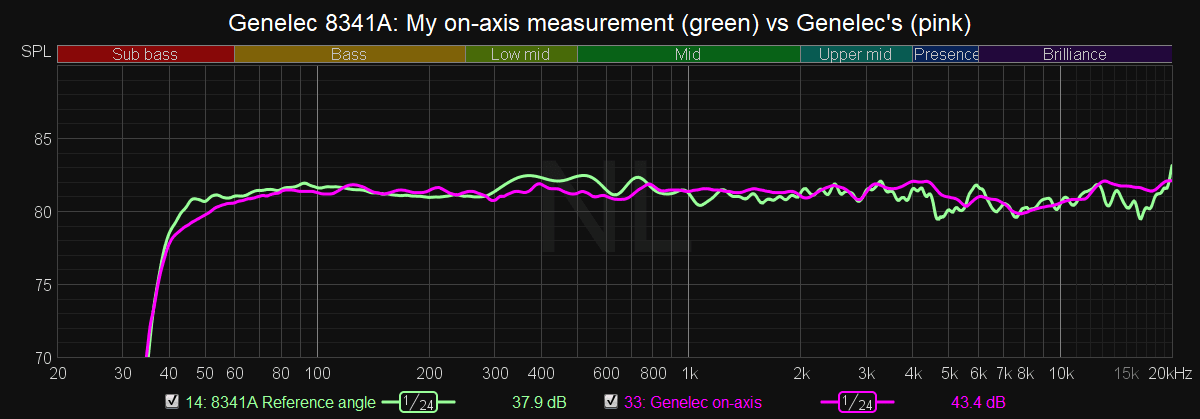
Next we take a look at the purple line, the ‘predicted in-room response’. It applies different weightings to each of the 70 angles to estimate what the speaker’s average response will be like in a typical living room setup (the PIR is always very similar to the simpler ‘early reflections’ curve in blue, so some spinoramas omit the former). Yes, living rooms vary a lot, but it’s still a surprisingly reliable metric above roughly 300-500Hz (below that, the room has an increasingly unpredictable impact on the sound).
Ideally, this line will look like a flattish line too, except tilted down by a few decibels. Most speakers struggle to have both a flat direct sound and a flat, tilted in-room response, but that is exactly what the 8341A gives us.
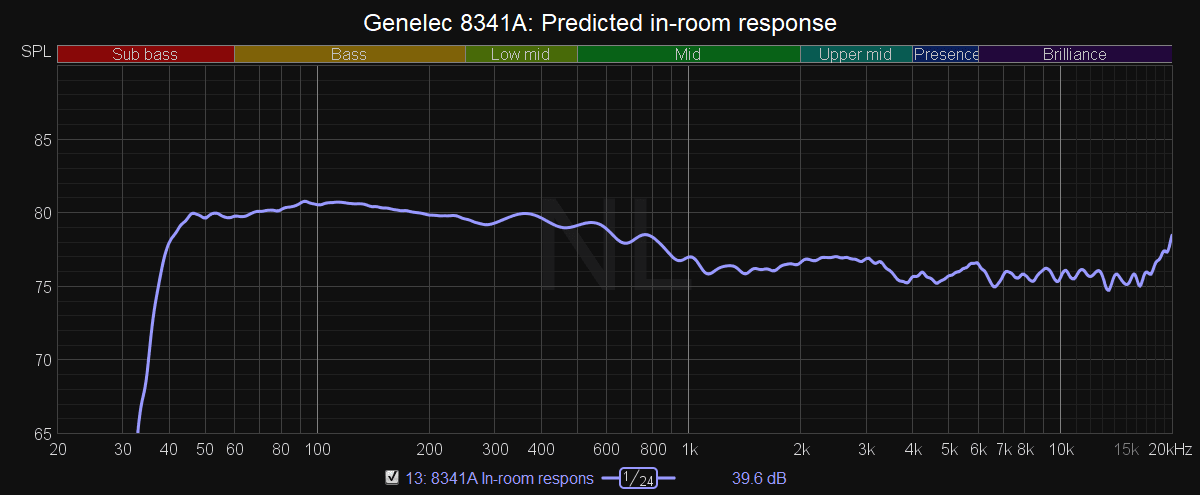
These two lines already tell us that the speaker will have an extremely neutral tonality in most setups. The signal that is being fed to the speaker is pretty much what’s coming out of them, without highlighting or hiding any particular region of the frequency response. On most music, they will sound fantastically transparent. Of course, not all music is mixed the same and some individual tracks may sound better on other speakers, but research suggests that a flattish response is what is most enjoyed by listeners. Individual taste factors less into it than you might expect.
We can also see from the above that the 8341A has excellent bass extension for a speaker its size, able to comfortably reach 40 Hz. It will have some audible energy into the upper 30s in room (for reference, the lowest note on a bass guitar is about 41 Hz). While I always suggest adding a subwoofer in order to get those lowest frequencies (those last 20Hz count for a lot, especially for modern music), these speakers don’t feel completely lacking without one and should perform well with most “real”-instrument genres.
In terms of tonality, it really doesn’t get much better than the 8341As performance, and pushing for any flatter is firmly in the realm of diminishing returns. The flat response also provides a nice base for equalization should you want to tweak things to taste, and the 8341A includes several switches on the back that can tune the response to varying degrees.
We can then assess the speaker’s soundstage performance by looking at its ‘directivity.’ This is essentially how the speaker’s sound changes at different angles.
Remember, both the direct and reflected sound affect what we hear, and it’s the relationship between the two that largely defines a speaker’s soundstage performance. We want the reflected sound to closely match the direct sound. If it doesn’t, not only will tonality be affected, but the imaging will become muddy too.
Again, the 8341A is impeccable. The blue line near the bottom of the spinorama is ‘the early reflections directivity index,’ and it tells us most of what we need to know. This line should generally be smoothly rising, without major peaks or dips. That’s what we get.
The yellow dotted line, the ‘horizontal ERDI,’ is only the horizontal component of the above. It is not an official part of the spinorama standard, but I include it because horizontal performance is far more important for soundstage realism. The horizontal ERDI line is even smoother, basically guaranteeing the 8341A will have excellent imaging performance.
Taking a more granular look, we can see what the estimated reflections off the walls in front, to the side, and to the rear of the speaker will be like.
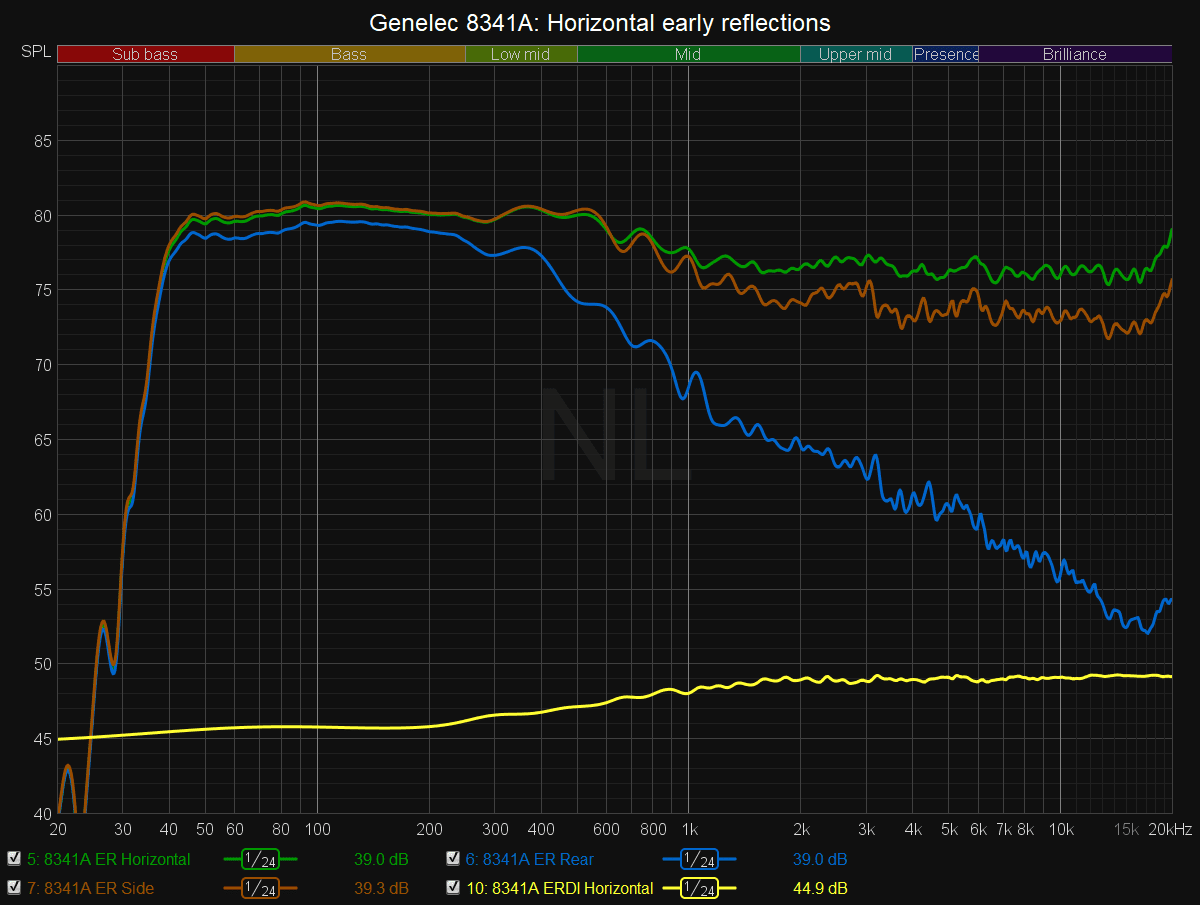
We can further break things down by looking at the exact measurements of the 8341A in 10-degree horizontal intervals.
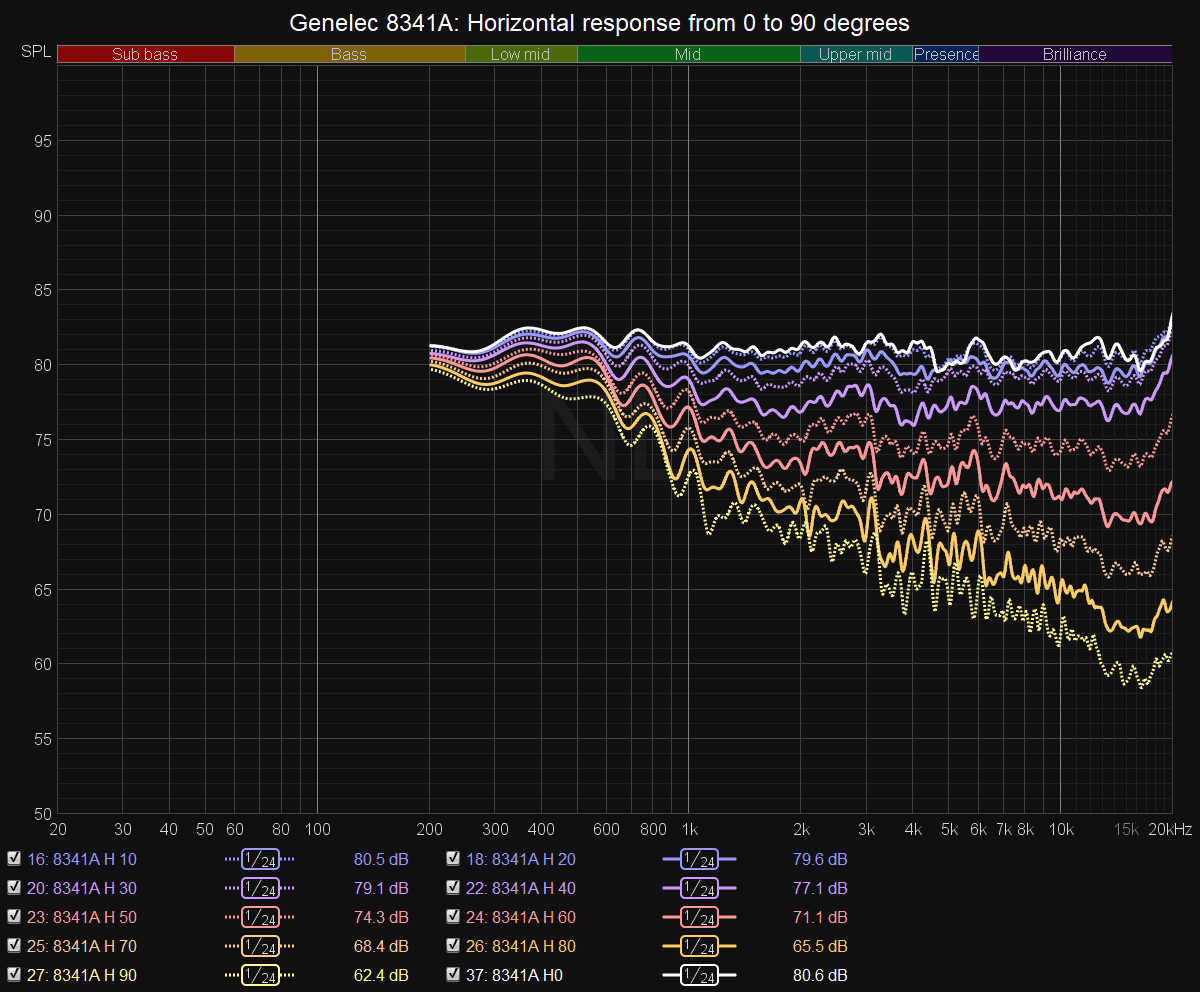
It’s all fantastic.
The emphasis on horizontal performance doesn’t mean the vertical performance doesn’t matter at all. Indeed, the 8341A goes the extra mile by having pretty much perfect vertical directivity too. We can see the estimated reflections off your ceiling and floor closely match the rest of the data.

Good vertical performance helps to avoid coloration of the sound and helps ensure the speaker delivers good sound from room to room.
Delving deeper, below is the vertical response from 0-90 degrees below the tweeter (the performance is nearly identical in the other direction, as the speaker is mostly symmetrical):
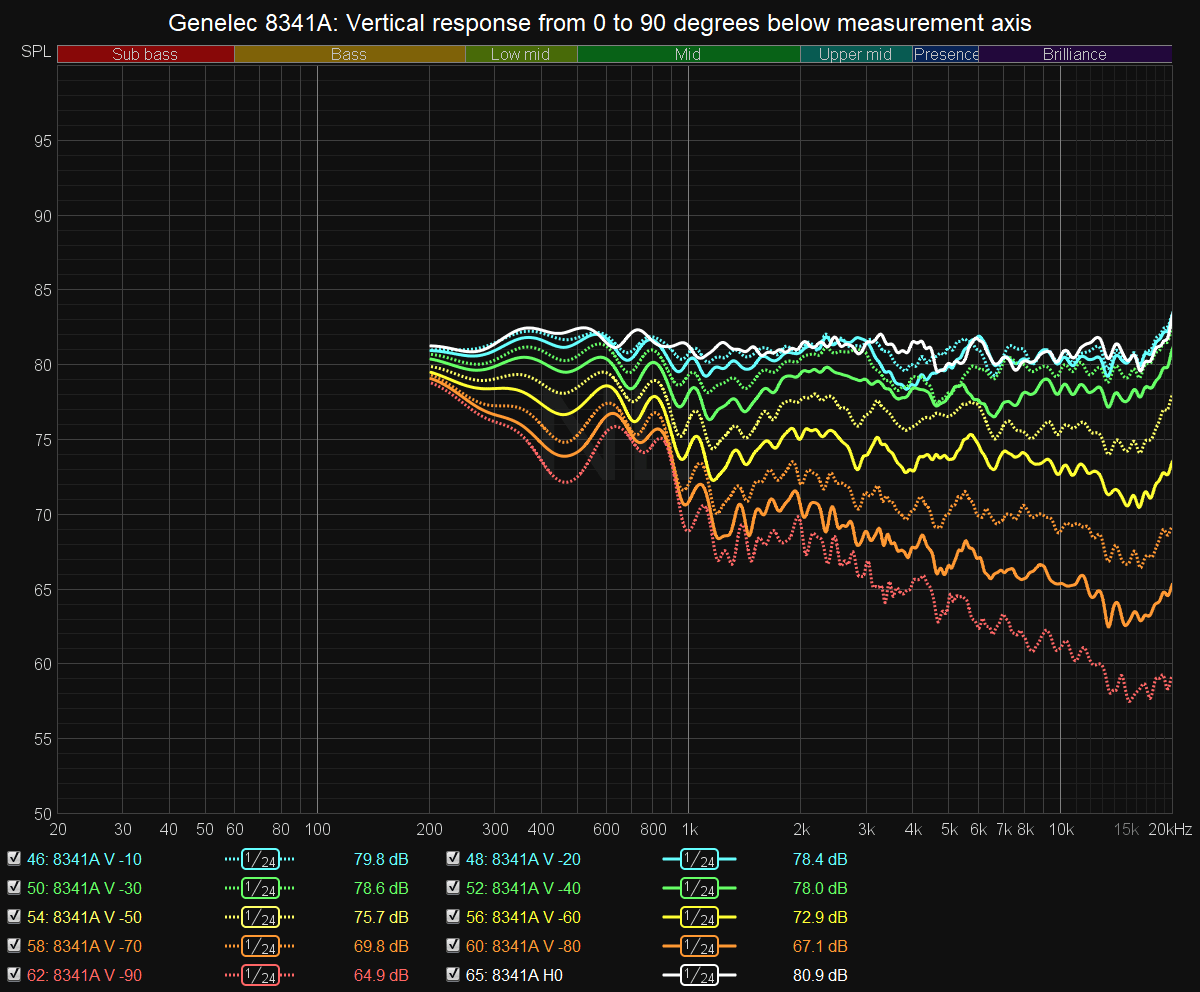
This excellent vertical performance is also why you can turn the speaker on its side without significantly deteriorating the sound. Most speakers are significantly compromised in this orientation.
Subjectively, the 8341A’s imaging performance is kind of glorious. You can pinpoint instruments in a track like nobody’s business, but the soundstage isn’t too narrow. That said, while a flattish frequency response and even directivity are almost always good, there’s a lot more personal preference in how wide or narrow a speaker’s soundstage should be.
I do personally gravitate to a speaker with wider directivity, and it’s just about the only thing keeping the 8341As from being perfect for my tastes. The soundstage only slightly extended past the speakers themselves in my testing. But there’s always at least a bit of a trade-off between soundstage ‘sharpness’ and ‘size’ with a two-speaker setup; pick your poison. Many recording engineers gravitate towards a narrower, sharper soundstage, so this is unlikely to be an issue for them.
It’s also worth noting that Genelec knows that a listener’s room is often the weakest link in an audio setup, the lower mids and bass region in particular. Extremely few speakers are equipped to deal with this region (the D&D 8C is a notable exception, and is better than the 8341A for it). But to this end, the company has its optional GLM room correction kit, which does a bang-up job of dealing with nasty room colorations. It is one of the very best room EQ suites around; you haven’t heard good sound until you’ve heard properly managed in-room bass.
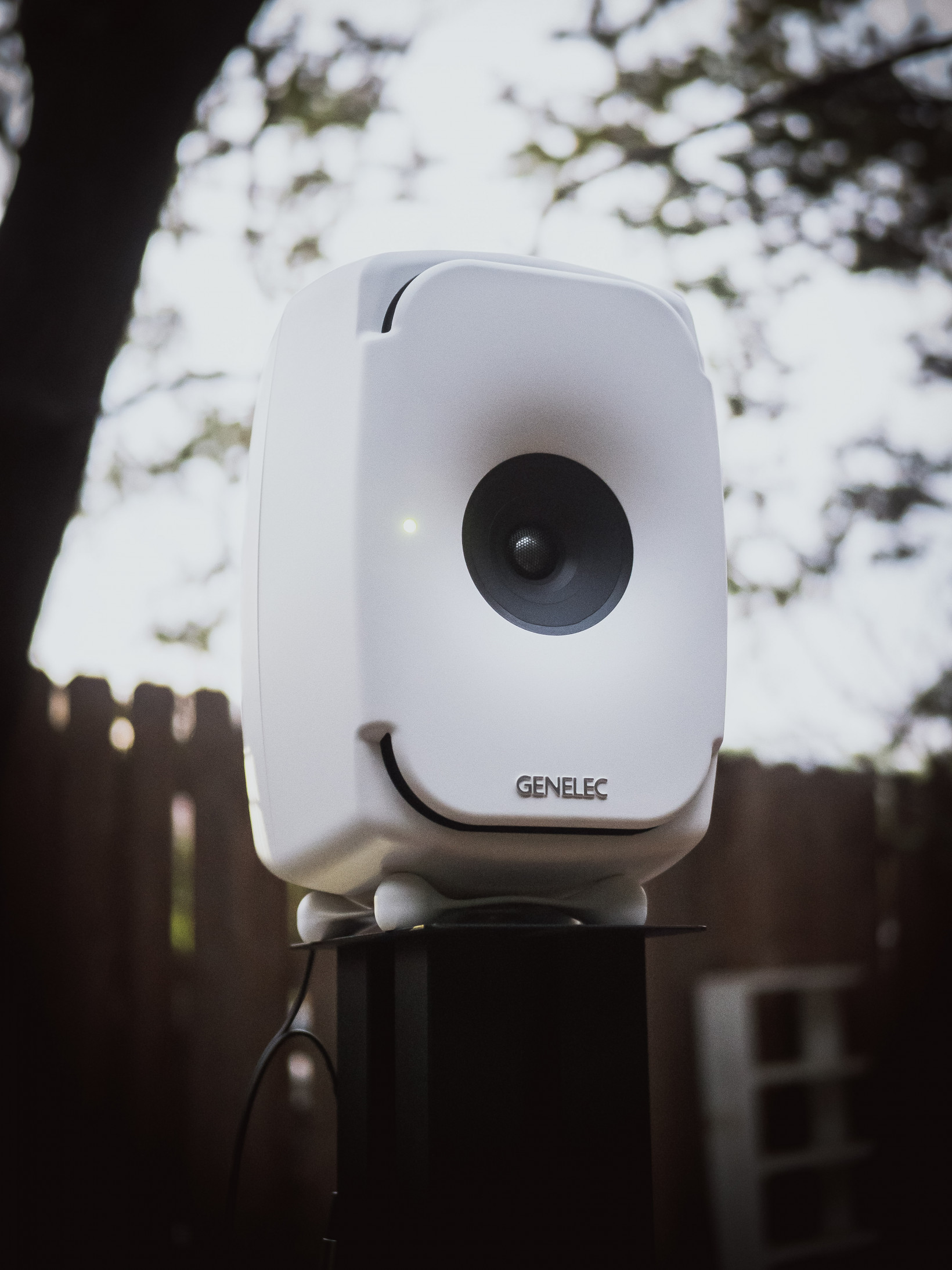
It’s harder to measure and meaningfully interpret other aspects of sound like dynamics and distortion. Luckily, research suggests that frequency response and directivity are by far the most important metrics of a speakers performance; the rest tends to follow. In my listening tests, I came across no noticeable distortion and dynamics seemed impeccable, although I do not tend to listen very loud. Just don’t expect a pair of fairly compact monitors to fill a room the way floorstanders or some of Genelec’s larger speakers might (although the addition of a subwoofer could largely rectify this).
You may think I focused too much on the data and not enough on describing the sound, but it’s hard to write about a speaker this good. Everything just sounds ‘correct.’ Rather than making its presence obvious, the speaker disappears and just lets you enjoy your music (or find all the flaws in your mix).
Isn’t that all we really want from our speakers? Genelec’s flagship series may be way out of most people’s budgets, but whether you’re an audio professional whose job relies on good sound, or an audio enthusiast who just wants textbook performance, the 8341A is near the state of the art. It’s the rare speaker that might really, truly let you hear music “as the artist intended.”
Get the TNW newsletter
Get the most important tech news in your inbox each week.


